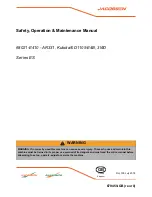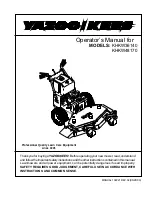
Not for
Reproduction
31
Regular Maintenance
Check Engine Coolant Level
The engine coolant level and quality should be
checked before each use, when the engine is cool
and off.
The cooling system is a closed type. Never open
the radiator cap unless you are flushing the system.
Opening the radiator cap may induce air into the
cooling system and may cause overheating.
1. Open the hood to gain access to the overflow
bottle. (See Figure 18).
2. Check the coolant level only at the overflow
reservoir (A, Figure 18). The coolant level should
be at the LOW (COLD) mark.
3. If the coolant level is insufficient, remove the cap
(E) from the reservoir and add coolant to the
LOW (COLD) mark. See engine owners manual
for specific engine coolant specifications.
4. Reinstall the cap.
NOTE: Proper coolant mix is a 50/50 mixture of
ethylene glycol and distilled water. See engine
owners manual for engine coolant specifications.
Change Engine Coolant
See engine owners manual for specific engine
coolant procedures. The drain valve is located at the
base of the right-hand side of the radiator.
Clean Radiator & Screen
Clean the radiator (A, Figure 19) and screen befo
re
each use, or as required (depending on conditions) to
allow proper air-flow through radiator and hydraulic oil
cooler.
1. Raise the seat plate.
2. Lift the radiator screen (B) straight up to remove
the screen. Flush the screen with water or blow
clean with air. Flush the radiator core with water
or blow clean with air. See engine owners manual
for proper radiator cleaning procedures.
Figure 19. Cleaning the Radiator & Screen
A. Radiator
B. Radiator Screen
Figure 18. Checking the Engine Coolant Level
A. Overflow Reservoir
B. LOW (Cold) Mark
C. FULL (Hot) Mark
D. Cap
B
A
FULL
LOW
A
B
C
D
WARNING
If engine is warm, DO NOT remove radiator
cap.
Escaping steam can cause burns.
Never remove the radiator cap or radiator
reservoir cap while the engine is hot or
running. Severe thermal burns or injury
can occur by escaping steam or hot
coolant.
• Do NOT touch hot radiator or open reservoir
when engine is running.
• Stop and allow engine to cool before removing
the radiator cap or the reservoir cap and before
changing or adding coolant.
3. Reinstall the radiator screen. Make sure the
screen is fully seated in the carrier.
4. Lower the seat plate.
















































